
It’s time for another entry in FNY’s Cross Streets of NYC series!
I’ve done them piecemeal in the past, but I’ve already posted 20th Street, 21st Street, 22nd Street, 17th Street, 10th Street, 6th Street, 18th Street, 25th Street, 26th Street and 34th Street in this batch, and 14th Street as well in autumn 2019 with more to follow. Before the Great Infection, I spent a number of Saturdays (and some Sundays too) crisscrossing Manhattan via its numbered streets. Over the years, I’ve done this quite a few times and I was amazed at how much stuff I missed and how much material I knew about and posted here and there, but never really formalized or categorized. Eventually I might make these “crosstown” posts their own separate category. In late summer, I resumed the crosstown walks.
Today (in mid-September 2020) I chose 38th Street, which runs from the Franklin D. Roosevelt Drive west to 11th, with, of course, 5th Avenue dividing it into East and West sections. In recent years, I have walked its parallel streets in Manhattan to the north, 39th Street and 40th Street.
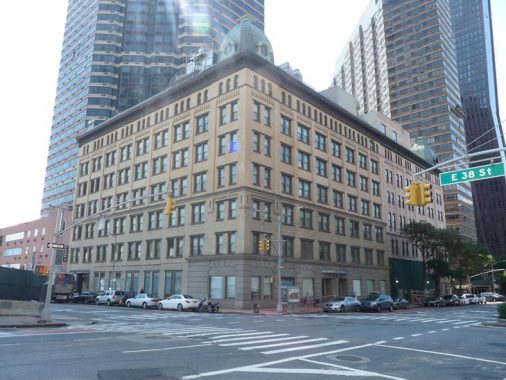
This imposing brick structure with corner copper domes on 1st Avenue between East 37th and 38th was constructed for the Kips Bay Brewing Company in 1895 and continued as a brewery, surviving Prohibition, until 1947. It currently hosts a number of doctors’ practices; Bellevue Hospital is ten blocks to the south.
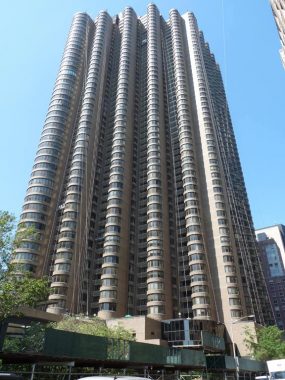
The incredible Corinthian apartment tower, with its myriad bay windows, was constructed in 1987 by architect Michael Schimenti at #645 1st Avenue between East 37th and 38th.
According to Jim Naureckas of New York Songlines, Corinthian “is used to mean ‘luxurious’ because Corinth was the party town of ancient Greece–noted as the home of Aphrodite’s sacred prostitutes. The fountain in front of the building is called Pierene – named for the fountain in Corinth where the flying horse Pegasus was captured.” Of course you remember Ricardo Mantalban’s “Corinthian leather” car commercials in the Super Seventies.
When I hear “Corinthian,” though, I recall Neil Gaiman’s Corinthian character from his Sandman comic book series in the 1990s. At first a killer and later more sympathetic, the Corinthian usually wore sunglasses, to hide the fact that his eyes were open mouths.

East 38th Street crosses approach and exit roads of the Queens Midtown Tunnel, which goes under the East River and feeds traffic to and from the Queens Midtown Expressway (I-495) which becomes the Long Island (Horace Harding) Expressway and runs east all the way to Riverhead in Suffolk County, characterized by some as “the world’s longest parking lot” because of its frequent jams, though plenty of NYC roads can claim that title.
The tunnel was designed by Norwegian American engineer Ole Singstad and opened for business in November 1940. Amazingly its approach roads still boast their original “Machine Age” lampposts, complete with Westinghouse “cuplights.” To me they’re architectural marvels. They have been given fresh paint jobs in black in recent years.
As a matter of fact, parts of the Queens Midtown Tunnel run beneath East 38th, and the eastbound tube of the Lincoln Tunnel runs under West 38th!
Murray Hill
Murray Hill is generally accepted to lie between East 34th and 40th Streets between Madison Avenue and the East River. It is named for the mercantile Murray family, who migrated to New York from North Carolina and Pennsylvania in the mid-1700s. Patriarch Robert Murray lived in a grand mansion called Inclenburg at today’s East 36th and Park Avenues; a plaque on a building marks the site today. Inclenburg was situated on a high hill that has since been leveled, but there are still a number of inclines remaining in Murray Hill, particularly on 3rd Avenue in the 34th Street vicinity. Today its chief public attraction is the J.P. Morgan mansion at Madison and East 36th, which is now the Morgan Library and Museum. Mrs. Robert Murray, according to legend, was responsible for delaying the British advance on Manhattan Island by having British officers in for tea and cookies at Inclenberg!
Murray Hill was known as a carriage district and one of Murray Hill’s more picturesque ones can be found at 149 East 38th, just west of 3rd. The George Bowdoin Stable is a landmarked structure dating to 1902 (the date is emblazoned between the 2nd floor windows). The stepped facade was a hallmark of Flemish architecture. It was built for a local honcho, Richard Martin, but acquired by Bowdoin, a business partner of J.P. Morgan, in 1907. What does the bulldog represent?
Your webmaster, of course, was not vouchsafed a peek at the interior, but this NYTimes article supplies an idea of what it looked like in 1997:
The surprises continue on the other side of the facade of the former stable, purchased this year by Donald Saff, an artist and consultant, with some of the unexpected features of the interior having a distinctly late-20th-century feeling of whimsy. The novelty inside ranges from the practical — such as extensive use of skylights and glass-block walls — to those that Mr. Saff refers to as ”James Bond” (a remote-control box in the master bedroom raises a curtain to a sunlight-filled shaft, and turns on lights and music) and ”Miami Vice” (pink neon lights in pillars leading to the commercial kitchen).
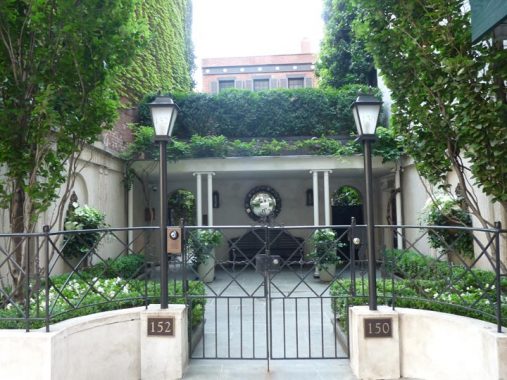
Directly across the street, meanwhile, at 150-152 East 38th is another landmarked building, which is an 1858 gatehouse said to have belonged to a member of President Martin Van Buren‘s family. The house (only the top floor can be seen from the street) is set back far from the curbline and was given this extensive facade in 1934 by architect Robertson Ward — a ‘gate’ in front of a gatehouse. The property was further renovated in 2001.
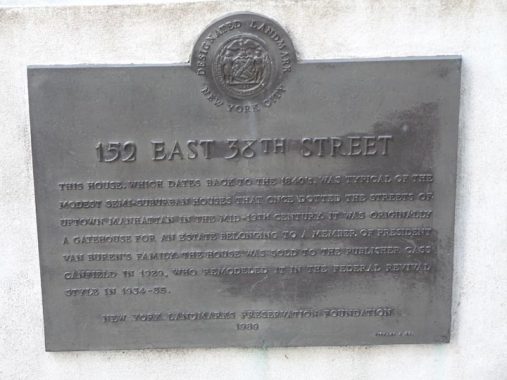
The late Christopher Gray’s research for The New York Times indicates that the building was built by a Patrick McCafferty in 1857, so any connection with Van Buren is purely conjectural, despite what the historic plaque says.
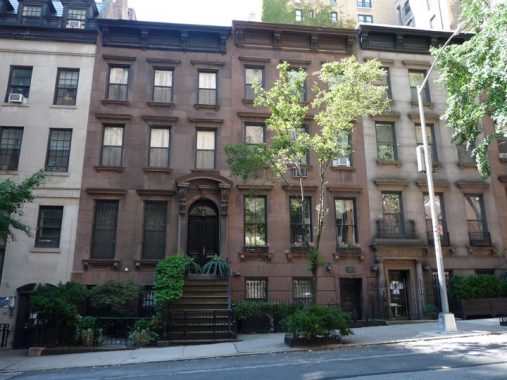
A trio of handsome attached brownstone buildings, #142-146 East 38th, just east of the Murray Hill Historic District.
The Cuban Mission to the United Nations is located in this high rise building on the NE corner of Lexington Avenue and East 38th. When Fidel Castro was in power the building was heavily guarded and was the focus of several protests, mainly by Cuban Americans.
Brothers to the Rescue is a Cuban-American nonprofit organization based in Miami that is pledged to assist refugees from the Communist island nation; it was formed in 1991 after the death of refugees traveling from Cuba to Florida aboard makeshift rafts. When the city honored the organization by designating the entire intersection for the group, Cuba protested the move in the United Nations.
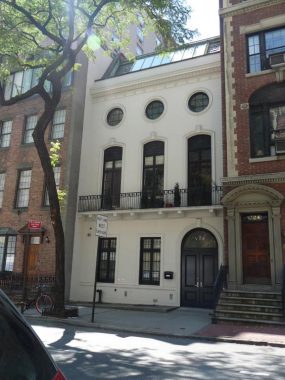
Much of East 38th Street between Park and Lexington Avenues falls within the Murray Hill Landmarked District. The designation report linked above gives a thorough description and history of the Murray Hill neighborhood, as well as complete architectural details of the buildings within it. The entire block is worth a visit but I will focus on a few individual buildings here.
#126 East 38th was much-altered in 1916 from its original purpose but you can still tell that it’s another former carriage house. It was designed by Delano & Aldrich and was built in 1869. The architectural firm also designed the Marine Air Terminal at LaGuardia Airport.
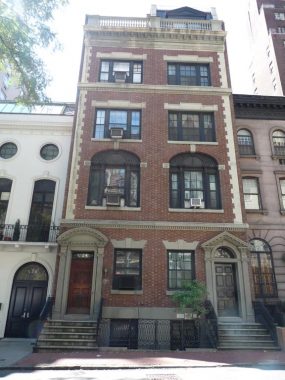
Next door is what appears to be a single building but note the two entrances: these are #122-124 East 38th Street. Each were built between 1902 and 1904 for William R.H. Martin. #122 was owned at one point by the son-in-law of Robert Todd Lincoln (which made him the grandson of Abraham Lincoln).
Tom Miller, the Daytonian in Manhattan, has a comprehensive history of #122 as well as some interior photos.

A handsome trio on the north side of East 138th, #115-119. All are French Second Empire-style townhouses built in 1864. Prominent architect Robert H. Robertson purchased #117, the center building, in 1873. Robertson designed St. Luke’s Episcopal Church; the influence of that church helped save Alexander Hamilton’s uptown residence.
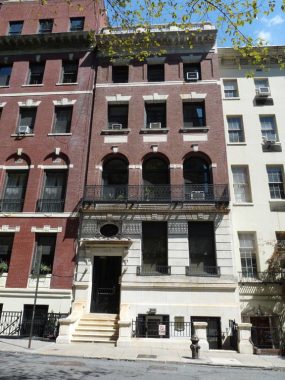
#109 originally looked like its brothers #115-119 when built in 1864 but it received the full makeover treatment in 1909 into a Federal style townhouse in part by the firm of the aforementioned R.H. Robertson and Benjamin R. Moore… the grandson of Clement Clarke Moore of “A Visit From St. Nicholas” fame.
Not the best time of day to get a photo of the Catholic Church of Our Savior at the SE corner of Park and East 38th, but I deal with the light I get. The parish and church are relatively new, 1955 and 1959 respectively. The Latin inscription over the door means “The Lord is risen indeed.”

Though the block of East 38th between Park and Madison isn’t in a Landmarked district, this townhouse at #36 is designated. It’s another townhouse constructed in 1864 but this one was remodeled in a (somewhat over the top) Beaux Arts style in 1904 for prominent Wall Street attorney Middleton S. Burrill and his wife Emilie Neilson Burrill.
Nearly out of the photo at left is #38, yet another rowhouse remake. It was originally owned by jewelry dealer Henry Randel.
Ever-present sidewalk scaffolding doesn’t make taking a picture of #7 East 38th easy but I wanted to get some of the Deco-era metal scrollwork in as well as the octagonal, or stop sign-shaped transom window.
At the NW corner of 5th Avenue and West 38th, I skipped getting a photo of the Lord & Taylor building, but fear not, I discussed the now-shuttered store in FNY previously.
Did you know that cofounder Samuel Lord had holdings in Elmhurst, Queens? You wouldn’t believe what it looks like now.
We are now getting into an area with prominent buildings that are nonetheless not landmarked, so information I have on them is sketchy. #15 West 38th is so massive I couldn’t get its enormity into one photo, since I backed up as far as possible on the sidewalk. The date of construction, 1908, is displayed in Roman at the roofline, easily visible only from the top floors of the building I’m standing in front of, looking up.
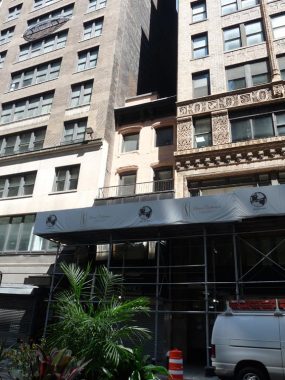
Further west, there’s tiny #55 West 38th, wedged between skyscrapers, which it probably predates by several decades.
#63 West 38th is an interesting 1930 building decorated with terra cotta eagles and other ornamentation; it’s the Refinery Hotel, a boutique enterprise with a 1920s theme. It runs through a block north, #64 West 39th.
Garment District
West of 6th Avenue we plunge into NYC’s still-vibrant Garment District. Clothing wholesalers still pack the side streets, as they have since the early 20th Century. More than any other NYC neighborhood, “faded ads” advertising such wholesalers are still inscribed on the tall office buildings that line these streets. Only now are most of them fading into illegibility. The Garment is one of the largest of NYC’s mercantile “fiefdoms,” running from about West 29th Street north to west 41st between 6th and 8th Avenues.
A milliner is a manufacturer and/or distributor of women’s hats, and the Garment District featured dozens if not hundreds of hat manufacturers in an era when men wore flat brimmed hats of various shapes and sizes, and women wore various hats of varying styles, one more outrageous than the next, in the early to mid-20th Century after which hats decreased in popularity beginning in the 1960s.
So many Jewish milliners and other clothing manufacturers worked in the area that the Millinery Center Synagogue was established in 1933, with the present building by architect H.I. Feldman went up in a striking Moderne building at 1025 6th Avenue, just north of West 38th, in 1948.
More clothing wholesalers on West 38th between 6th and 8th Avenues.
There’s a surviving painted ad for a nearby Horn & Hardart Automat above the Jimmy’s 38 NYC restaurant and events pace (below a parking garage) at West 38th just west of 7th Avenue.
A few years ago, Forgotten Fan David Silver got on the roof of that very parking garage and got an up-close photo of the painted ad.
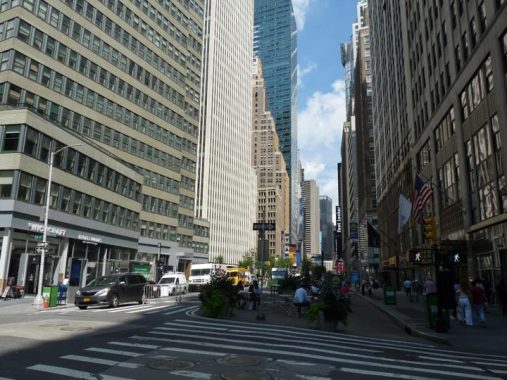
Broadway was formerly a handy way for cabbies and other motorists to defy Manhattan’s strict grid pattern by using the diagonal route from Columbus Circle south to Union Square, but traffic “engineers” have decided to place bicycle lanes and pedestrian plazas liberally, making true traffic flow difficult. Here, we are looking north on Broadway from West 38th.
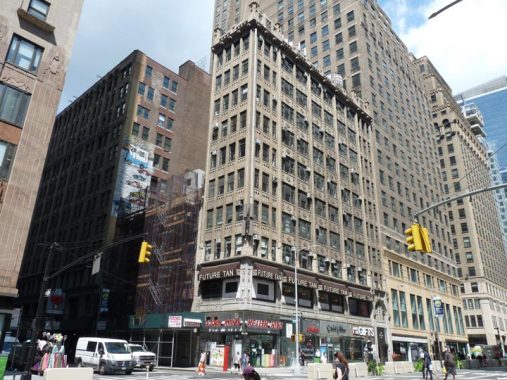
7th Avenue between 34th Street and Times Square is something of a 1920s time capsule as the lion’s share of office buildings on both sides of the street were built during that decade. 526 7th Avenue at West 38th has a lot of frontage on 7th, and only a few feet on West 38th. There are a pair of gnomes guarding the door on 7th Avenue that I don’t have photos of, you’ll just have to visit the building to see them.
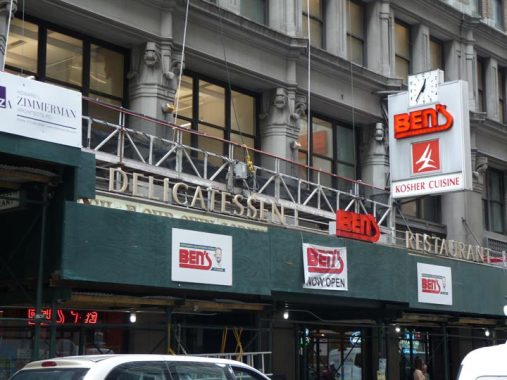
I have sampled the treats at Ben’s Kosher Deli here on West 38th and in a Bayside branch on numerous occasions. There are also chain locales in Westchester and Nassau Counties and in Boca Raton, FL.
A few doors away at #203 West 38th had been the Spanish Tavern, which was promoted incessantly on the Bob Grant radio show in the 1980s.

Here’s the impressive Midtown West branch of the post office, with its Corinthian pilasters, or half columns. On 221 West 38th, just east of the building, is a still-visible painted ad for Globe Electrotype, located in the building from 1912 to 1932.
Midtown west, in the upper thirties, had been a hotbed for printers and typesetters. 45th Street on the east side (where I worked for Photo-Lettering for 7 years) is another. I briefly worked in a type shop on West 38th, Line & Tone, in very early 1992. I found the coworkers difficult to talk to. One day, someone confided in me that the owner went through people so quickly, it was no use getting to know them. Sure enough, I was laid off after three months, when they would have to start paying health insurance. (Another instance of this occurred in 2012 — relative silence from coworkers followed by dismissal after 3 months — at Medallion Retail, another print operation I was briefly involved with.)
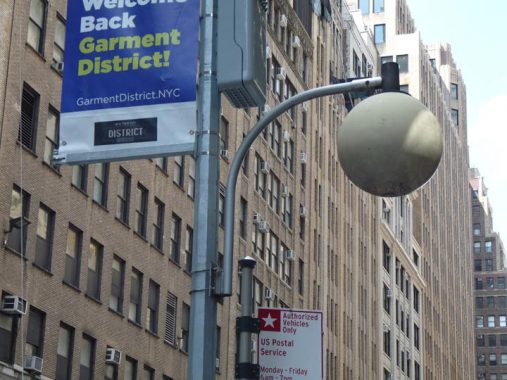
At some point in the Super 70s — I forget which year now — the Department of Transportation thought that some Garment District side streets needed some extra illumination for the sidewalks. This part of midtown features block after block of tall masonry towers erected in the 1920s and 1930s, and much of the Garment District still looks like it must have looked in those years.
Well, as the years went on the DOT gradually switched out the big white globes in favor of high intensity sodium lamps and now, bright white LEDs. However, a pair of the Globes are left, here on West 38th between 7th and 8th and another one over on West 36th between Broadway and 6th Avenue.
I’d always ignored these Garment District lamps…but now that they’re rare…well, you know the score.

Accompanied on both sides of 8th Avenue by high-rise office buildings built in the 1920s and 30s, #300 West 38th Street, on the southwest end of what was Times Square’s sleaziest district holds forth bowed, perhaps bloodied over the years, but still intact, amazingly. It was constructed in 1903.
#300 West 38th was built as a hotel catering exclusively to actors that appeared in the many Broadway theaters located on the blocks north and east of this corner. Its chief architect was Hungarian immigrant Emery Roth (1871-1848) who went on to become one of the pre-eminent architects of hotels and residences in NYC — among his later designs were the Warwick Hotel, where the Beatles stayed during their first NYC visit in February 1964, as well as the St. George Hotel in Brooklyn and the twin-towered San Remo and Normandy Apartments in Manhattan. The firm Emery Roth & Sons is still active today and has designed dozens of prominent NYC buildings including the Pan Am, now Met Life, Building and with Minoru Yamasaki, the first World Trade Center.
I covered this building, as well as the now-demolished Kaskel & Kaskel Building on 5th Avenue, on this FNY page.
The Shampan 8th Avenue office building wraps around #300 West 38th on both sides. There are classical-style terra cotta work on each side. The name comes from the Shampan & Shampan architects, who designed and built it in 1927.
Next door is #304 West 38th, a 1928 building designed by William I. Hohauser that appears to have a lizard on the heraldry within its ogive-shaped entrance. This is actually a stylized representation of a salamander. Real ones are small-to mid-sized amphibians which resemble lizards but are soft to the touch and spend some of their time in the water, like their amphibian cousins the frogs. In the medieval period, salamanders got the reputation of being able to survive fire and in fact, it was believed that they had the ability to extinguish fire. They became heavily represented on royal crests and other ornamentation, and Alwyn Court terra cotta carvers took license with the creatures, giving them claws and showing fire coming out of their mouths.
The Esposito Meat Market, serving locals and also the restaurants further north on 9th Avenue, has been in business since 1932, many of those years here on the SW corner of 9th Ave and West 38th. Its vinyl-lettered sign is in the colors of the Italian flag, red, light green and white. The signage features an “animal cannibal,” a pig licking its chops.
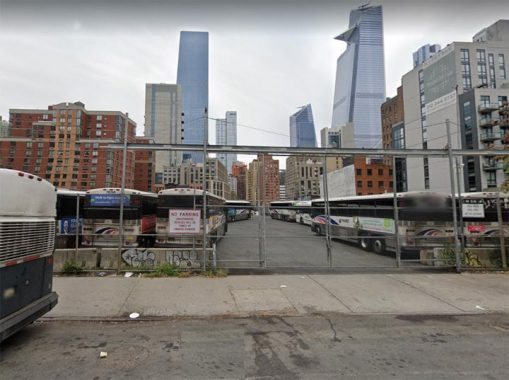
Between 9th and 10th Avenues West 38th Street passes over several on and off ramps of the Lincoln Tunnel; an inbound tube is underneath West 38th between 10th and 11th Avenues.
Looking south from an overpass over one of the approaches, the view is of the new Hudson Yards complex. The observation deck on the building at right, known as the Edge, is billed as the highest observation deck in the western hemisphere, and actually has an “indestructible” glass floor portion.
However, this comes at a price to access and it is only for those who feel like coughing up a $40+ admission fee.
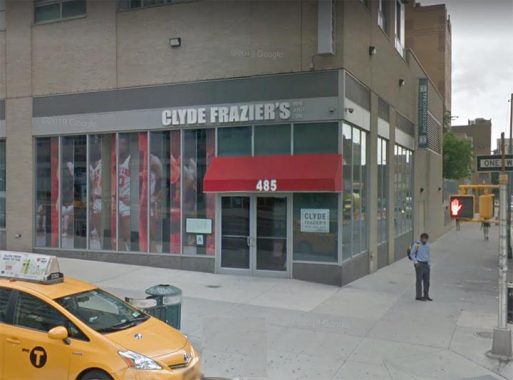
Walt “Clyde” Frazier played guard for the New York Knicks between 1967 and 1977, leading the team to three NBA Finals, winning two in 1970 and 1973. He was nicknamed Clyde after 1930s bank robber Clyde Barrow, who wore sharp suits while participating in his chosen profession. Since 1989 he has worked as an analyst on Knicks game telecasts, describing bad basketball (by the home five) for the last twenty years. The Knicks have not won a championship since he distributed the ball.
Frazier owns Clyde Frazier’s Wine & Dine a few blocks from Madison Square Garden at 10th Avenue and West 38th.

Decades-old buildings are harder to find in the West 30s west of 9th Avenue. One is H&L 21/Engine 26, at #438 West 38th. The plaque indicates that the firehouse was built in 1937, during the Fiorello LaGuardia administration.
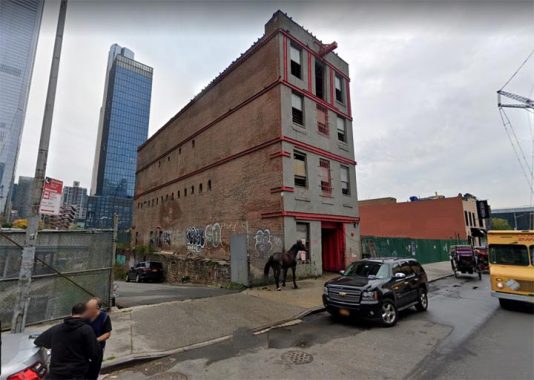
Earlier, we have seen a few converted stables. At #538 West 38th between 10th and 11th Avenues, alongside an overpass over the West Side Freight Railroad, you’ll occasionally smell some horseshit or see a nag or two hanging around. The West Side Livery has been here since the 1860s and is one of four stables on the west side hostling the Central Park carriage horse business.
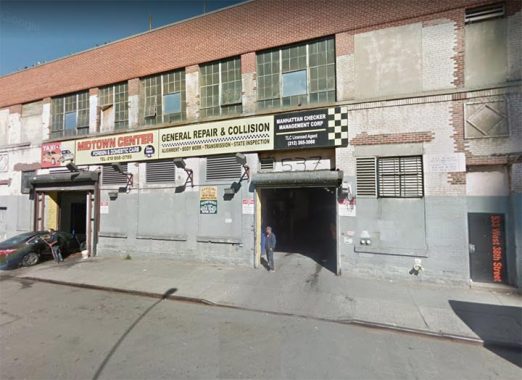
Directly across the street at #537 is another kind of stables serving and repairing Dobbins of a different type.

West 38th Street ends (or begins) at 11th Avenue at the north end of the green, glassy Jacob Javits Convention Center. The “Jav” replaced the New York Coliseum as NYC’s premier convention center in 1986, though both the Democratic and Republican parties have continued to use Madison Square Garden as a Presidential nomination venue since that year when in New York. Primary events in recent years have been the New York Auto Show and Comic Con. In 2020, it was employed for a time as a field hospital for Covid-19 patients.
NYS Senator Jacob Javits (1904-1986) was that now extinct beast, a “liberal” Republican. He served as a senator from 1957 to 1980, when he was defeated by Al d’Amato, who in turn was defeated by Democrat Chuck Schumer.
Check out the ForgottenBook, take a look at the gift shop, and as always, “comment…as you see fit.”
10/11/20


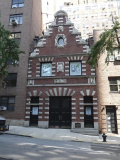
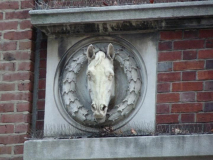

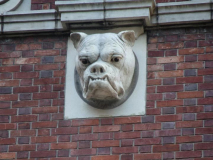
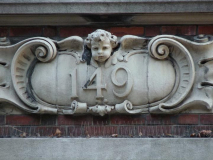

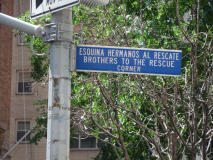
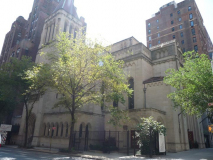

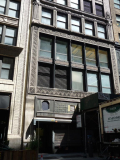
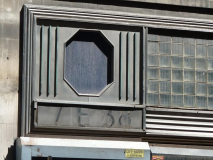

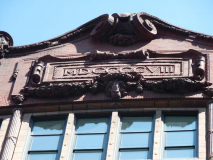
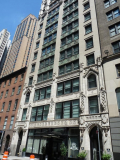

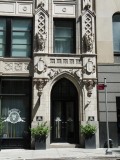
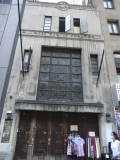
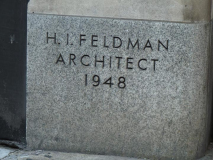
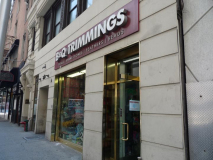
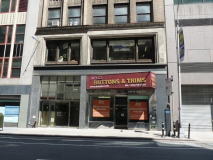
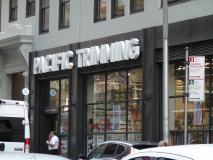
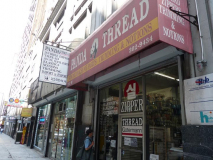


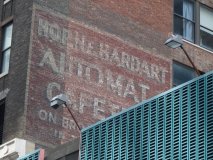

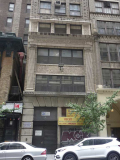
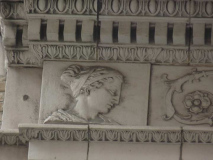

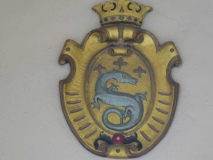
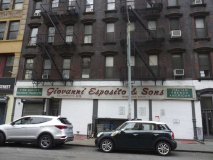
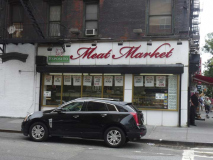
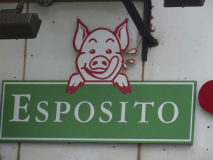
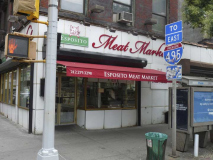
10 comments
Enjoyed your comment about “Liberal Republicans.” Senator Javits certainly fit that moniker, but there were many other such Republicans in the days when the GOP realized that attracting a diverse electorate was the key to victory. Other notable examples in New York – Mayor John Lindsay (who switched to the Democratic Party in 1971 while he was Mayor but never was elected to another office); and Governor Nelson Rockefeller. Interestingly, Rockefeller, and Lindsay, despite their similar leanings, had a very adversarial relationship. NYC has a Javits Center and a Rockefeller Center, but as far as I know, no structure is named for John Lindsay.
Would this count? NYC Parks: John V. Lindsay East River Park
I’m fine with including this location, but it’s not on a par with the Javits and Rockefeller namesakes. Nothing official, of course. Thanks for sharing this. Lindsay began his mayoralty with a lot of promises that evaporated in an unending crisis of crime and social unrest that were not his doing. I was in college, began working, and got married during his two terms so I saw those events first hand.
Thank you for digging up one of my grandfather’s utilitarian creations. He passed away a month after I was born in 1961 so his architectural output is a bit of a mystery to the grandchildren. Plus my immediate family was not very good with keeping records or mementos.
Ben’s Deli Manhattan location, 209 W. 38th St., has some historical significance. In 1925 it became the site of a well-known full-service kosher restaurant, Lou G. Siegel’s, which derived much of its business from the garment trade executives in the immediate area. Ben’s took over the location in 1997 when Siegel’s closed the restaurant to concentrate on catering. More info on this website:
http://www.lougsiegel.com/index.php/our-story
I ate there on a number of occasions before it became Ben’s, which (at least on my last visit a few years ago) still displayed much of the 1950s Lou G. Siegel’s décor.
Nicely done.
One thing that needs to be pointed out: when mentioning firehouses, the engine company is always listed first. It’s tradition, with ladder companies second and the rescues, battalions, divisions, and specialized units third. They get very upset being listed any other way, I’ve made the mistake and gotten the snub until apologizing for the flub.
It’s too bad that Tiffany’s isn’t on 38th Street, because it would go with this title, which is also a song of theirs’, “Breakfast at Tiffany’s.”
Horn and Hardartts were always good for “free” food when we were kids.What you do is take a cigarette butt(which were all over the floor)and find a compartment on the wall that is empty but the guy on the other side hasnt refilled with a plate of
food,and you insert the butt between the swinging door and latch and close the door on it…..Hell,every kid in NY knows the
rest,need I spell it out?
Grandfather grew up in the building next door to the firehouse. His building has since been demolished (sometime in the 90s) – thus the empty lot you see next to the firehouse. Many buildings were demolished in that neighborhood earlier with the construction of the tunnel and Port Authority.
Thank you for posting the little known Emery Roth building by my great grandfather on the corner of 38th and 8th. You missed the one at 252 West 38th Street.